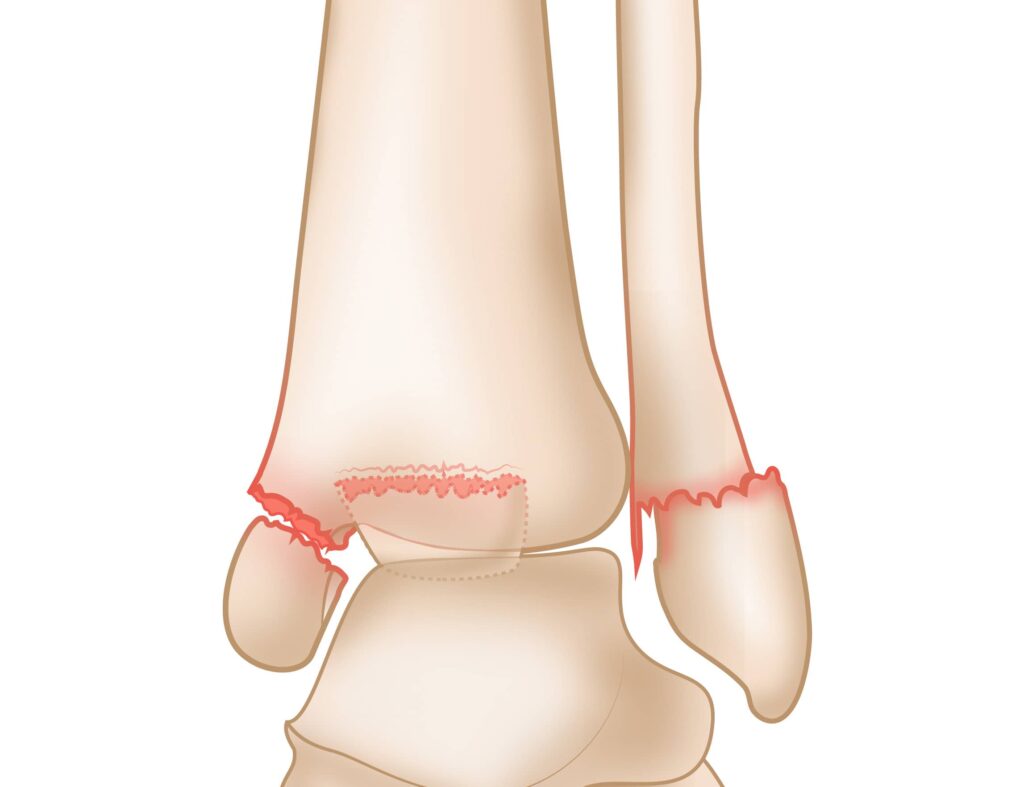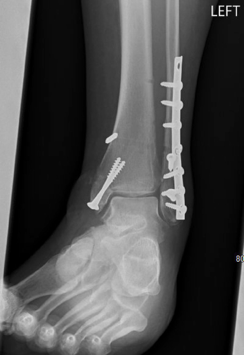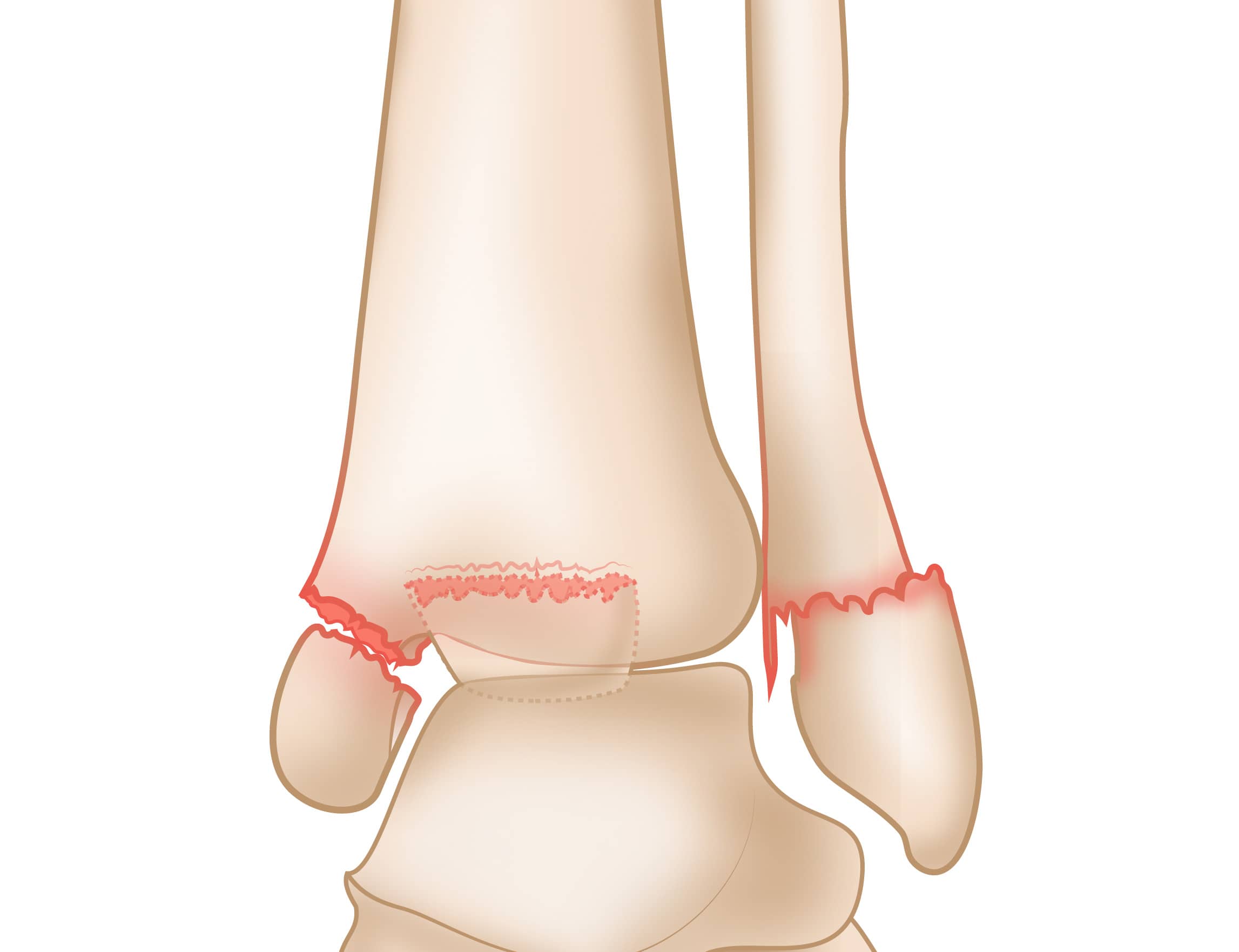What is an ankle fracture and how does it happen?
If your ankle joint twists during and injury or fall, you can break one or both bones of the ankle joint. This is called an ankle fracture – we use the words fracture and break to mean the same thing.


Will I need an operation?
Whether you need an operation will depend on the position of the bones after the break and how likely they are to stay in the same position.
If the bones are in a good position (which is only slightly different to how they would normally be) and it is likely that they won’t move further, then your ankle fracture may be treated without an operation in either a plaster cast or a special boot.
You may need to come back to the fracture clinic a week and sometimes two weeks after the injury and have another X-ray to ensure the bones are still in a good position.
However, if the bones are out of place and are unlikely to stay in the same position, it is likely you will be offered surgery to align the bones and ankle joint into the correct position. This will usually done with plates and screws and your surgeon will explain the risks and benefits of your specific surgery.
Do I have to have surgery?
The main aim of any surgery around a joint such as the ankle joint is to restore the joint function and minimise the risk of arthritis (pain and stiffness) developing in the joint.
If the bones are not correctly aligned and they are allowed to heal in an abnormal position, there is a more likely chance that the joint will become painful and stiff.
Again, your surgeon will explain the risks and benefits to your specific injury. If you decide not to have the operation, you will be treated in a plaster cast and advised to not put any weight through the cast for 6 weeks.
If I need surgery, when will I have it?
There is often a lot of swelling around the ankle after an injury and we often have to wait a few days or even a couple of weeks for all of the swelling to settle down before it is safe to make cuts in the skin for surgery. You may be allowed to go home and return for an operation.
You may need to come back to the fracture clinic a week or so after your injury to check the swelling and confirm a date for surgery. The co-ordinators will be in touch with you regarding clinic appointments and dates for surgery.
In the meantime, you can keep your leg elevated as high as possible (above the level of the groin) on pillows. Ice packs can also help.
What happens during the surgery?
You will see the anaesthetic doctor on the day of surgery and you will most likely have a general anaesthetic (you’ll be asleep) and/or a regional nerve block to help manage your pain after the operation.
The ankle fracture will most likely be fixed with plates and screws and you may have one or more cuts around the ankle joint.
You will be given painkillers and advice about weight bearing after the surgery.
If you have come in as a day case you will likely go home the same day, but if you are already in the hospital, you may need to stay in a night or two in the hospital depending on the severity of the injury and the extent of the surgery.
What are the risks of ankle fracture surgery?
The risks of any operation generally relate to the anaesthetic and the surgical procedure.
You will be able to discuss your anaesthetic options and associated risks with the anaesthetist before your surgery. With a general anaesthetic, the risks will vary depending on your general health.
The main surgical risks of an ankle fusion are listed below, but it is not exhaustive. These will be further explained in the outpatient clinic.
Blood clots (leg or lung) – There is small risk of developing a blood clot after major surgery. You will be individually assessed and may be given blood thinning medication to reduce the risk of developing a blood clot.
Failure of union (healing) – There is a small risk your ankle fracture does not following surgery, and may need to be rectified with a second operation. Patients who smoke are at a much higher risk of this complication. We will therefore ask you to stop smoking (including nicotine vapes) before surgery and while your ankle joint is fusing together. We can direct you to services that can help with smoking cessation.
Infection – The risk of infection with any foot and ankle operation is up to 5%. The majority are minor infections that can be simply treated with antibiotics. Occasionally, some patients can develop a deeper infection that might require another operation.
Nerve injury – With an operation, there is always a small risk of injuring or stretching the surrounding nerves, which can lead to numbness or even weakness. These symptoms mostly resolve in time, but they can persist.
Swelling – The ankle will swell after surgery in response to the surgery and the healing process. It will take more than 12 months for the swelling to settle and some may persist.
Mal-position – When the ankle fixed there is a very small risk that it may not be in the correct position. If the position of the ankle is problematic some patients may consider further surgery to adjust this. Great care is taken during surgery to avoid this complication.
Prominent metalwork – If the metalwork in your ankle becomes a problem, you can have another operation to remove it. After nine months the ankle fracture will be solid so the screws and / or plate can be removed if required.
Failure of the implants: this occurs when there is loosening or breaking of the plates and screws. This can occur for many different reasons and may require a further operation. It is important to follow the surgeon’s advice about weight bearing.
Pain over the plate and screws: The plates and screws are just under the skin and if they irritate you a lot, they can possibly be removed at a much later date, but only when the bone has fully healed. We do not remove plates and screws routinely as they often do not cause any harm.
Post traumatic arthritis – At the time of the injury the forces placed through the ankle may damage the joint and you can subsequently develop arthritis. This may require further treatment.
Chronic regional pain syndrome – Following foot and ankle surgery a very small proportion of patients can develop chronic regional pain syndrome. Your foot becomes indefinitely painful, swollen and sensitive. If you develop this, you may require specialist care from a pain consultant.
What happens after my operation?
How soon will I recover?
You will likely be in a plaster cast for between 2 and 6 weeks after surgery or you may require use of a special boot at some point in your recovery – this will depend on the type of injury and surgery you had and your surgeon will advise.
You will be seen by the physiotherapists after your operation to ensure you are safe on your crutches or walking frame.
If you smoke or vape, you should try to stop as nicotine can stop the wounds and bones from healing and delay your recovery.
It is likely you will be unable to drive for 6-12 weeks and you will likely need a minimum of 6 weeks off work depending on the nature of your job. You can discuss this with your surgeon.
When will I go home after surgery?
After surgery, most patients can go home the following day. You may require additional time in hospital, if you have other significant medical problems or general poor mobility.
Will I be able to walk on it after surgery?
For the first six weeks after surgery you are advised not to put any weight through your operated leg. Before you go home the physiotherapist will make sure you are safe to get around on crutches. Some patients though find crutches difficult. A knee scooter can be easier to use and information can be provided on this.
Also, in the first few weeks keep your leg elevated as much as possible to help reduce the swelling and aid wound healing. It is important that your cast remains dry and you may find using a waterproof cover helpful (www.limboproducts.com).
When will I be seen after surgery?
You will be seen two weeks after surgery in the outpatient clinic. Your wounds will be checked, your stitches removed, and a usually a walking boot will be applied.
You will then be seen six weeks after surgery with an X-ray.
Some fractures following surgery can tolerate walking with all your weight through it, whereas others need additional protection with no weight placed through the limb. Your surgeon will guid you as to what is right for you.
Further appointments will depend on your individual progress.
When can I go back to work?
If you have a sedentary job (desk based) and are able to elevate your foot, you can return to work six weeks after surgery. If you have a more physically strenuous job, you may need significantly longer off work. Generally, after an ankle fusion it takes up to 12 months to gain the full benefit.
When can I drive?
You can start driving when you are comfortably walking in your own footwear. If you cannot safely make an emergency stop your insurance will not cover you in the event of an accident. Start by sitting in the car and trying the pedals, then drive round the block. Drive short distances before long ones. If you are having surgery on your left leg and drive an automatic car, you could consider to start driving sooner, but only if you are safe to do so.
How quickly can I return to activities?
After an ankle fusion it varies how quickly people can return back to some activities. When comfortable in your own shoes, gradually build up your walking distances. Playing golf is possible but it is rare to participate in running sports. You will be guided by our physiotherapists during the rehabilitation program.
When can I fly after surgery?
If you are flying after recent surgery you are at an increased risk of developing a blood clot in one of the deep veins in your body, usually the leg (deep vein thrombosis or DVT). Please ask your surgeon for individual guidance on how long to delay flying after your surgery. Also, each airline has its own regulations about flying after surgery and you will need to check with your airline before flying.
What about the future?
Most patients make a good recovery after surgery and return to their normal activities.
It is important to follow your surgeon’s instructions and do the physiotherapy exercises.
Some swelling and mild stiffness and last for several months after the injury and there will always be a risk of developing arthritis after the injury.
Wellbeing advice
Patients that have a healthy diet, take regular exercise and refrain from smoking are more likely to experience a quicker recovery with a more successful outcome from their surgery.
Taking vitamin C supplements for six weeks before surgery and six weeks after surgery can also be beneficial. You can purchase them from your local pharmacy or supermarket.
If you have any concerns about your general health and well-being (diet, exercise, smoking cessation) you are encouraged to discuss this with your GP, who will be able to provide advice on the options available to you.
We hope this leaflet has answered any questions you might have. If you have any further queries, please feel free to discuss them with any of the medical or nursing staff.
Useful links: https://www.nhs.uk/conditions/broken-ankle/
Last modified: April 6, 2023







